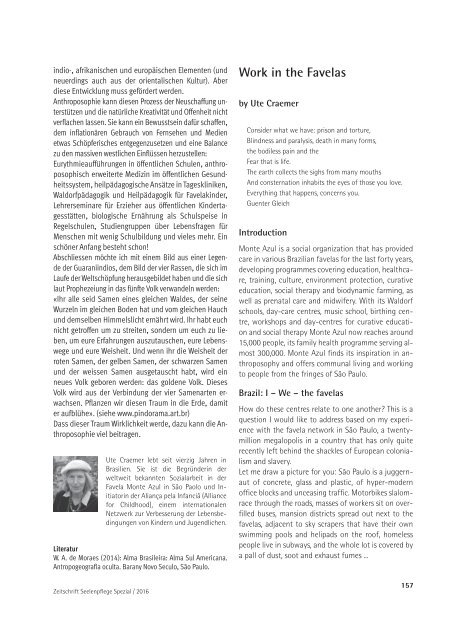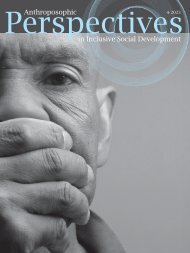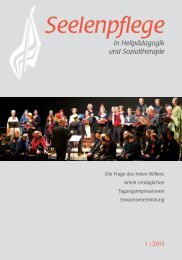Seelenpflege 2016-3-4 Spezial
Seelenpflege 2016-3-4 Spezial
Seelenpflege 2016-3-4 Spezial
You also want an ePaper? Increase the reach of your titles
YUMPU automatically turns print PDFs into web optimized ePapers that Google loves.
indio-, afrikanischen und europäischen Elementen (und<br />
neuerdings auch aus der orientalischen Kultur). Aber<br />
diese Entwicklung muss gefördert werden.<br />
Anthroposophie kann diesen Prozess der Neuschaffung unterstützen<br />
und die natürliche Kreativität und Offenheit nicht<br />
verflachen lassen. Sie kann ein Bewusstsein dafür schaffen,<br />
dem inflationären Gebrauch von Fernsehen und Medien<br />
etwas Schöpferisches entgegenzusetzen und eine Balance<br />
zu den massiven westlichen Einflüssen herzustellen:<br />
Eurythmieaufführungen in öffentlichen Schulen, anthroposophisch<br />
erweiterte Medizin im öffentlichen Gesundheitssystem,<br />
heilpädagogische Ansätze in Tageskliniken,<br />
Waldorfpädagogik und Heilpädagogik für Favelakinder,<br />
Lehrerseminare für Erzieher aus öffentlichen Kindertagesstätten,<br />
biologische Ernährung als Schulspeise in<br />
Regelschulen, Studiengruppen über Lebensfragen für<br />
Menschen mit wenig Schulbildung und vieles mehr. Ein<br />
schöner Anfang besteht schon!<br />
Abschliessen möchte ich mit einem Bild aus einer Legende<br />
der Guaraniindios, dem Bild der vier Rassen, die sich im<br />
Laufe der Weltschöpfung herausgebildet haben und die sich<br />
laut Prophezeiung in das fünfte Volk verwandeln werden:<br />
«Ihr alle seid Samen eines gleichen Waldes, der seine<br />
Wurzeln im gleichen Boden hat und vom gleichen Hauch<br />
und demselben Himmelslicht ernährt wird. Ihr habt euch<br />
nicht getroffen um zu streiten, sondern um euch zu lieben,<br />
um eure Erfahrungen auszutauschen, eure Lebenswege<br />
und eure Weisheit. Und wenn ihr die Weisheit der<br />
roten Samen, der gelben Samen, der schwarzen Samen<br />
und der weissen Samen ausgetauscht habt, wird ein<br />
neues Volk geboren werden: das goldene Volk. Dieses<br />
Volk wird aus der Verbindung der vier Samenarten erwachsen.<br />
Pflanzen wir diesen Traum in die Erde, damit<br />
er aufblühe». (siehe www.pindorama.art.br)<br />
Dass dieser Traum Wirklichkeit werde, dazu kann die Anthroposophie<br />
viel beitragen.<br />
Zeitschrift <strong>Seelenpflege</strong> <strong>Spezial</strong> / <strong>2016</strong><br />
Ute Craemer lebt seit vierzig Jahren in<br />
Brasilien. Sie ist die Begründerin der<br />
weltweit bekannten Sozialarbeit in der<br />
Favela Monte Azul in São Paolo und Initiatorin<br />
der Aliança pela Infanciã (Alliance<br />
for Childhood), einem internationalen<br />
Netzwerk zur Verbesserung der Lebensbedingungen<br />
von Kindern und Jugendlichen.<br />
Literatur<br />
W. A. de Moraes (2014): Alma Brasileira: Alma Sul Americana.<br />
Antropogeografia oculta. Barany Novo Seculo, São Paulo.<br />
Work in the Favelas<br />
by Ute Craemer<br />
Consider what we have: prison and torture,<br />
Blindness and paralysis, death in many forms,<br />
the bodiless pain and the<br />
Fear that is life.<br />
The earth collects the sighs from many mouths<br />
And consternation inhabits the eyes of those you love.<br />
Everything that happens, concerns you.<br />
Guenter Gleich<br />
Introduction<br />
Monte Azul is a social organization that has provided<br />
care in various Brazilian favelas for the last forty years,<br />
developing programmes covering education, healthcare,<br />
training, culture, environment protection, curative<br />
education, social therapy and biodynamic farming, as<br />
well as prenatal care and midwifery. With its Waldorf<br />
schools, day-care centres, music school, birthing centre,<br />
workshops and day-centres for curative education<br />
and social therapy Monte Azul now reaches around<br />
15,000 people, its family health programme serving almost<br />
300,000. Monte Azul finds its inspiration in anthroposophy<br />
and offers communal living and working<br />
to people from the fringes of São Paulo.<br />
Brazil: I – We – the favelas<br />
How do these centres relate to one another? This is a<br />
question I would like to address based on my experience<br />
with the favela network in São Paulo, a twentymillion<br />
megalopolis in a country that has only quite<br />
recently left behind the shackles of European colonialism<br />
and slavery.<br />
Let me draw a picture for you: São Paulo is a juggernaut<br />
of concrete, glass and plastic, of hyper-modern<br />
office blocks and unceasing traffic. Motorbikes slalomrace<br />
through the roads, masses of workers sit on overfilled<br />
buses, mansion districts spread out next to the<br />
favelas, adjacent to sky scrapers that have their own<br />
swimming pools and helipads on the roof, homeless<br />
people live in subways, and the whole lot is covered by<br />
a pall of dust, soot and exhaust fumes ...<br />
157






